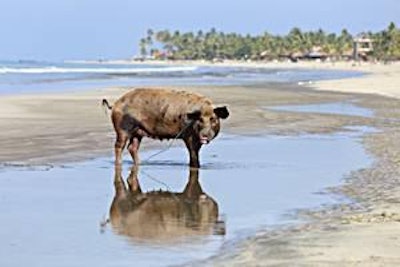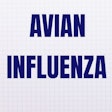
Because hot weather reduces feed intake, animal feed nutritionists and pig producers need to review sow feed formulas to better prepare them for high temperatures.
Pig producers usually reduce crude protein and fiber in feed, because these nutrients emit more heat during digestion and metabolism, compared with carbohydrates and fats. Lipids, fats and oils are added to formulations to increase dietary density, so pigs and livestock consume more energy, even though they reduce their overall feed intake when stressed. Synthetic amino acids are also included to maintain the ideal energy-protein balance to keep pigs growing.
But, none of these feed formulas fully restore animal performance back to normal, because for livestock to be able to consume the same amount of nutrients and produce the same quantity of “usable” product (meat, milk, eggs) would mean certain death from apoplexy due to heat stress.
While all of these feed formulas are used on most pig farms today, little consideration is given to additives that could equally help pigs and livestock cope with heat stress.
Effects of heat stress
Heat stress causes increased respiration rate. This leads to increased losses of carbon dioxide from the lungs, which reduces the partial pressure of carbon dioxide, and consequently the concentration of bicarbonate in the blood.
The ensuing lowered concentration of hydrogen ions causes a rise in plasma pH, a condition widely known as alkalosis. Blood alkalosis is considered partially responsible for depressed feed intake and the consequent impaired performance in heat-stressed animals. To this end, certain additives are known to be beneficial in restoring blood pH.
However, certain additives can help pigs cope with acute high environmental temperatures. Of course, any product or nutritional strategy that reduces the amount of heat generated during digestion and metabolism will help.
Additives to reduce heat stress
Chronic exposure to high ambient temperatures reduces the effectiveness of these additives as the organism begins to adapt via a number of other mechanisms.
Sodium bicarbonate . This additive is used mostly for pigs because it can improve feed intake under heat stress. Feeding sodium bicarbonate to young pigs is strongly discouraged as this ingredient tends to buffer stomach pH, which is already outside required limits in weaned piglets, reducing protein digestion.
Chloride salts . Potassium chloride and ammonium chloride, can improve growth performance, as well as reduced pig mortality. However, high dosages of potassium chloride can have adverse effects. These salts also can be used in drinking water.
Vitamin C . Ascorbic acid, is not required by mammals under normal conditions, several research reports have demonstrated that an increase in vitamin C can help alleviate heat stress by reducing cortisol and ADH levels. Because an increase in Vitamin C requirements cannot be met by internal synthesis, external supplementation is required.
In pigs, Vitamin C supplements are best reserved for lactating sows that are under the most stress during the summer months, as they need to be able to consume large quantities of feed to cope with the large litters produced today. Vitamin C also can be administered in a water supply system, where its dosage can be easily altered to reflect anticipated heat waves. This is usually combined with an electrolyte pack.
Betaine . Also known as trimethyl glycine, betaine derived from sugar beet, is a known osmo-regulator that helps animals suffering from water dehydration. Betaine balances water levels inside cells, and alleviates the negative effects of accumulated inorganic ions that destabilize cellular enzymes and other proteins. It is specifically beneficial in cases where animals only have saline water to drink as this accentuates their predicament.
Sodium zeolite . A natural clay and anti-mycotoxin agent, sodium zeolite can reduce the effects of heat stress on laying hens and is likely to have a similar effect in other monogastric animals.
Although the exact mode of action in which this product affects the ability of animals to withstand heat stress is unknown, it is believed to act as a buffer in the gastrointestinal system, reducing alkalosis associated with panting.
Enzymes . Carbohydrases and proteases can help heat stress in an indirect way. Because they increase feed energy and nutrient density, they can help animals receive more nutrients per unit weight of feed they consume. This is most relevant in the case of energy and protein, and not so in the case of phosphorus.
Breaking down non-starch polysaccharides also can reduce direct heat production, because these compounds being hardly digestible pass on the lower parts of the gastrointestinal tract where they promote bacterial fermentation (that emits heat).
Additives are integral
No single additive or nutritional intervention strategy can restore animal performance reduction during acute heat stress. Nevertheless, along with feed formulation, and feeding management, a number of additives should be considered in an integral approach.
Not all additives work the same in all species, and even within species there are classes of livestock that benefit more from a certain approach. So, leaving the usual formulae (as being used in the rest of year) unchanged for the summer is not an option!




.jpg?auto=format%2Ccompress&fit=crop&h=167&q=70&w=250)












